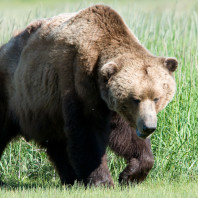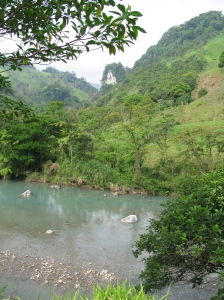Research Summary
The major themes in the lab are:
- Genome evolution
- Adaptation to extreme environments
- Conservation genomics
- Overwintering in cold environments
Genomic changes underlying adaptation to extreme environments
Extreme environments impose strong selective pressures on phenotypes and provide a context within which to explore specific questions about differentiation and adaptation. Multiple species and populations of Poeciliids have independently colonized multiple springs with toxic concentrations of hydrogen sulfide (H2S). The sulfide spring fish provide a unique opportunity for an integrative approach to studying adaptation because: 1. the environmental gradients are clearly defined and replicated, 2. the environmental gradients are physiologically explicit, with known biochemical consequences; and 3. the divergence between populations is recent. Together with Dr. Michi Tobler at Kansas State University, we are studying multiple sulfide spring populations and related non-sulfidic populations in the family Poeciliidae to understand parallel adaptation, adaptive trait divergence, differentiation in gene sequences, and gene expression patterns. We are taking a multi-omics approach to determine the relative contributions of different regulatory processes to the convergent phenotypes we observe in the sulfidic species.
Antifreeze proteins in polar fish
 One mechanism that polar species have evolved to survive in sub-freezing temperatures are antifreeze proteins (AFPs). AFPs have independently evolved multiple times in fish. AFPs interact with the leading edge of a forming ice crystal to reduce the freezing point and are identified as one of the key innovations that have lead to the radiation of species throughout the Southern Ocean. We combined Expressed Sequence Tag (EST) sequencing and proteomic analyses to demonstrate that antifreeze protein genes are under diversifying selection and all isoforms are expressed and translated in a single individual (Kelley, Aagaard et al. 2010 J Mol Evol). Eelpouts are globally distributed and Arctic and Antarctic eelpouts both have type III AFPs, which makes for a phenomenal global perspective on genome evolution.
One mechanism that polar species have evolved to survive in sub-freezing temperatures are antifreeze proteins (AFPs). AFPs have independently evolved multiple times in fish. AFPs interact with the leading edge of a forming ice crystal to reduce the freezing point and are identified as one of the key innovations that have lead to the radiation of species throughout the Southern Ocean. We combined Expressed Sequence Tag (EST) sequencing and proteomic analyses to demonstrate that antifreeze protein genes are under diversifying selection and all isoforms are expressed and translated in a single individual (Kelley, Aagaard et al. 2010 J Mol Evol). Eelpouts are globally distributed and Arctic and Antarctic eelpouts both have type III AFPs, which makes for a phenomenal global perspective on genome evolution.
We are sequencing, assembling and comparing the genomes of multiple polar and non-polar fishes, to clarify how rates of evolution vary in polar environments, identify general trends that shape the adaptive trajectories of cold-adapted marine fishes, and determine how functional differences shape the evolution of novel proteins by measuring thermal hysteresis activity of multiple AFP isoforms to link genotype to phenotype.
Functional genomics of seasonal changes in brown bears
 The brown bear experiences three major physiological shifts during a year, including active season, hyperphagia and hibernation. In collaboration with Profs. Charlie Robbins, Heiko Jansen and Omar Cornejo we are studying the transcriptional response to seasonal changes in brown bears. RNA-sequencing of multiple tissues has revealed complex regulatory changes that occur in response to extreme physiological changes. Currently, we are using additional functional genomics datasets, including single-cell resolution RNA-seq, ATAC-seq, and ChIP-seq, to better understand the regulation of key hibernation phenotypes. Ultimately, understanding the molecular mechanisms of hibernation in bears may enable the development of new treatments for human disease and injury.
The brown bear experiences three major physiological shifts during a year, including active season, hyperphagia and hibernation. In collaboration with Profs. Charlie Robbins, Heiko Jansen and Omar Cornejo we are studying the transcriptional response to seasonal changes in brown bears. RNA-sequencing of multiple tissues has revealed complex regulatory changes that occur in response to extreme physiological changes. Currently, we are using additional functional genomics datasets, including single-cell resolution RNA-seq, ATAC-seq, and ChIP-seq, to better understand the regulation of key hibernation phenotypes. Ultimately, understanding the molecular mechanisms of hibernation in bears may enable the development of new treatments for human disease and injury.
We are also building range-wide genomic databases for brown bear populations in North America to better understand their population dynamics. In close collaboration with the USFWS, we are building SNP panels that can be used as a monitoring tool.
Other ongoing projects in the lab include using functional, population, and evolutionary genomic analyses to understand the role of regulatory sequence evolution in the gain and loss of hibernation phenotypes across bears. This work aims to better understand how complex physiological adaptations evolve in vertebrates.
